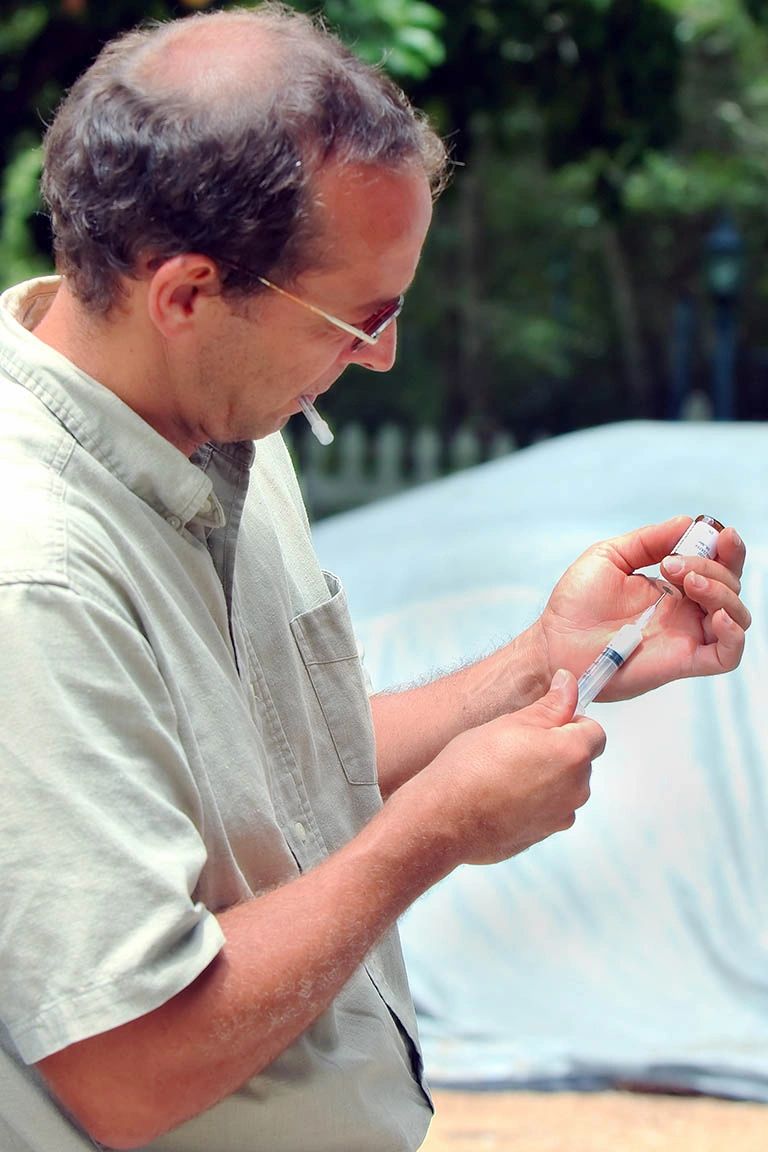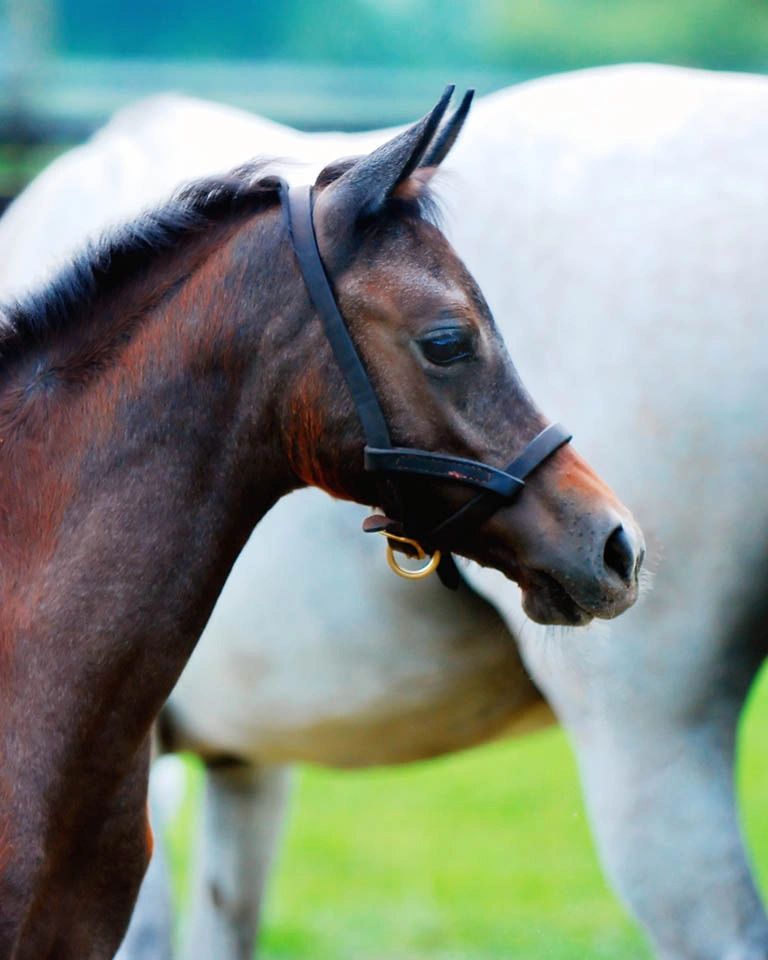
Keystone Equine Associates, P.A.
Equine Deworming Protocol:
In order to delve deeper still, may we suggest logging on to www.thehorse.com and click on the valuable deworming research by Dr. Craig Reinamayer at the University of Tennessee. This information was explicitly presented by our special guest speaker, Dr. H. H. Jody Wade, at our 2nd annual fall horse health seminar that was held in early October, 2009 in Odessa.
The basic vaccination of your horse is both safe and effective against the risk of severe disease and should be administered in order to avoid potentially devastating results. Vaccines are backed by extensive research in order to protect the horse from severe illness and/or possible death.
Protocols can vary due to exposure risk, immune competence of the horse and your geographical location. Keep in mind, the suggestions in the table below are based upon the endemic mosquito-borne diseases of our region.
The following vaccines are recommended by the American Association of Equine Practitioners as well as by our practice for adult horses in the Tampa Bay area:
| Vaccination | Questionable or Unvaccinated Status | Protocol |
| Tetanus | 2 doses, 4 - 6 weeks apart | Annual booster |
| Eastern/Western/Eastern Equine Encephalitis *See warning note below |
2 doses, 4 - 6 weeks apart/boost in 6 mos. | Every 6 mos. |
| West Nile Virus | 2 doses, 4 - 6 weeks apart/boost in 6 mos. | Every 6 mos. (one dose during June - Aug.) |
| Influenza | 2 doses, 4 - 6 weeks apart/boost in 3 - 6 mos. | Every 4 mos. (high exposure), every 6 mos. (low exposure) |
| EHV (Rhino) | 3 doses, 4 - 6 weeks apart | Every 4 mos. (high exposure), every 6 mos. |
| Rabies | Single dose annually | |
| Strangles | Intranasal - 2 doses, 3 wks. apart | Annual booster |

The vaccination of foals should ensue at three months of age. For other risk-based, vaccination protocols (e.g. pregnant mares) not referred to above, please go to www.aaep.org
"May 1st marks the traditional beginning of the mosquito season in our area, but the season is actually year round..." - Hillsborough County's Director of Mosquito Control, Carlos Fernandes, Ph.D.
Tell us what works best for you!!
If you are a current KEA client and would prefer to receive your vaccination reminder notice via text as opposed to e-mail, let us know at inquiry@keystoneequine.com as soon as possible.
During the past couple of years, there have been several confirmed and suspected cases of Eastern Equine Encephalomyelitis (EEE) virus in the state of Florida, specifically, northwestern Hillsborough County and counties to the north. Please pay special attention to your vaccination due dates. This is a preventable, deadly disease!
Did you know that unvaccinated horses have up to 30 times greater risk for West Nile disease?
Which equines are most suseptible?
Unvaccinated and young, less than three years of age. Recent arrivals to the Southeast are another high-risk group.
What signs do I look for?
They can be initially mild with fever and listlessness to the more severe, neurological and subsequently fatal encephalomyelitis. Typically, about five days after exposure, horses may have a high fever with depression and inappetence, elevated heart rates (even with the depression), lameness or instability. They usually progress with quickly deteriorating neurological signs. Afflicted horses also may show signs of coma, dementia, blindness, head pressing and seizure. Some owners have even reported that their horse appeared to be "intoxicated." A rapid personality change may indicate depression, sleepiness, hyperexcitability, mania, and self-mutilation (although more common with rabies). Up to 95% of EEE cases die, typically in approximately three days.
*A local warning was released on August 1, 2013, by the Florida Department of Health in Hillsborough County. The equine referred to in the article was seen by Dr. Garcia while on emergency call one weekend in mid-July. The horse had been recently acquired, arrived from another location outside of Florida and was likely never previously vaccinated. Following is a portion of this specific press release:
The Florida Department of Health in Hillsborough County Reminds Residents To Protect Themselves Against Mosquito-Borne Disease
TAMPA – The Florida Department of Health, Hillsborough County has confirmed that a horse located in the northwestern part of Hillsborough County was infected with locally acquired Eastern Equine Encephalitis (EEE). The horse was most likely infected mid-July and has since been euthanized.
The last human case of locally acquired Eastern Equine Encephalitis in Hillsborough County was in March, 2013.
"Preventing
mosquito bites can protect your health,” said Dr. Douglas Holt, MD,
Director, Florida Department
of Health, Hillsborough County. “That’s why it’s important for
residents and visitors alike to protect
themselves from mosquitoes and the illnesses they can transmit.” (Obviously, we are posting this notice because we are also emphasizing the importance of protecting your equine via vaccination. There exists no human vaccination as of this date, although research is currently underway... - KEA) Hillsborough
County has been under a Mosquito-Borne advisory since March 25.
Mosquito-Borne Illness
advisories are declared when human cases of locally-acquired
endemic or exotic arboviral disease
have been confirmed, or when evidence of intense
virus transmission activity has been detected
in animal surveillance systems.
__________________________________
Do not delay scheduling your semi-annual vaccinations. These preventable and deadly diseases are an extremely unpleasant experience for you, your equine and your veterinarian!
Stopping rabies starts with you!!
The best way to stop rabies is prevention. There are NO treatments for horses infected with rabies. It is always fatal once signs appear.
Signs of rabies infection include:
- A change in behavior, usually with the horse appearing dull or depressed (the most common sign)
- Colic
- Hyperexcitability
- Paralysis
- Convulsions
- Lack of coordination
- Excessive salivation
- Difficulty swallowing
- Aggressive behavior
Tips to help you prevent rabies:
- Ensure that your horse is vaccinated annually (a small price to pay to prevent horrific results)
- Make certain that any pets around the barn are vaccinated
- Report horse bites, especially if the horse's vaccination history is questionable or unknown
- Report wild animals or strays that are behaving strangely
- Avoid leaving out grain or other feed products
- Clean up exposed garbage
- Discourage wild animals from coming near barns or pastures
Dentistry:
The typical middle-aged horse should require a thorough floating of his teeth approximately every eighteen months. However, generally speaking, younger and older horses' teeth may require dentistry more frequently. Routine dental care is critical in performance (e.g. lead changes and ease of bitting) as well as maximizing nutritional intake. An average procedure takes approximately one hour and requires light sedation.
Normals:
*Temperature - 99 - 101 degrees F. - rectally with a thermometer
*Heart Rate - 30 - 40 beats per minute - check pulse or listen to heart with a stethescope
*Respiratory Rate - 10 - 15 per minute - merely watch him breathe
*Gum Color - should be light pink
*Capillary Refill Time (CRT) - 1 - 3 seconds - the time it takes for gums to "repink" after pressure is applied
Foaling:

There are three stages of foaling:
1) The mare is off feed, restless and lying down/getting up (up to 7 hours duration)
2) Cervical dilation, amniotic fluid rupture and subsequent birth (15 - 30 minutes)
3) Expulsion of the placenta (up to 3 hours)
The Foal:
*Once the foal is up and standing, encourage nursing from mare
*Dip the umbilicus with 1% iodine solution
*Administer enema
The foal should be examined by the veterinarian a minimum of 8 hours after the onset of nursing. In the event that the foaling is not "textbook" or any uncertainties exist, always consult with us. A foal exam will include but not be limited to, a general examination with an oral exam, ophthalmic exam, IgG (antibody) test, tetanus antitoxin and a placental exam.
The Mare:
*Check her vulva for tears
*Note if there is any excessive bleeding
*Check for milk production
*Save placenta in a cooler for examination by the veterinarian
Signs of Colic:
How do I know if my horse is exhibiting signs of colic? Here are a few things to look for:
*Unwillingness to eat at scheduled feeding
*Restlessness/sweating
*Biting and/or looking at side
*Pawing
*A desire to repeatedly lie down and/or roll
*Gums that are not pink (signifying pain/shock)
This is considered an emergency - Please call us for a clear evaluation of your horse's specific circumstances.
To assist in preventing sand colic, our practice strongly recommends the following protocol:
Use as close to a pure form of 99% psyllium husk (e.g. Equi-Aid, Sandclear, Select) as possible given once/twice a week in the feed ration based upon a dosage of 1 oz. per 200 pounds of body weight. The consistency of administering psyllium in your horse's diet is key in the prevention of sand colic.
________________________________________________________
During the fall/winter months of 2010 and into 2011, there seemed to be an over-abundance in the production of acorns from our native specie oak trees. These "nuts" are found on the ground in most pastures where horses are grazing and they are enjoying these treats in excess. They contain tannins and are potentially toxic. The proper and consistent administration of psyllium will assist to offset their consumption. If possible, put your horse within the paddock/pasture that offers the least amount of these pesky nuts.
General Nutrition:
Seven of the most common feeding mistakes are:
- Not paying enough attention to the quality of forage - Feed a high-quality timothy/alfalfa hay
- Do not overload the grain bucket - For most horses, the less grain fed, the better. Grains/feeds should be considered supplements and only used when supplementation is required - they are not a staple!
- Feed by weight, not by volume
- Do not give the wrong feed to the wrong horse - Remember that certain feeds are for specific horse types - growing youngsters, hardworking adults, broodmares, seniors, etc.
- Do not overload the nutrients - Ensure that you have a balance when adding supplements to your horse's feed
- Not offering a combination of sodium, chloride and potassium - These can be found in electrolytes and are essential to numerous bodily functions
- Ensure that you always offer plenty of fresh, clean, free-choice water
A nutrition program for the senior horse requires a balance of energy, protein, vitamins, minerals and fiber to assist in their body's changing needs and to maintain proper body condition. Our practice recommends a feed such as Purina Equine Senior to help deliver the necessary high quality fiber in a form that is beneficial for digestion and fermentation in the hindgut.
Signs of a Gastric Ulcer:
*Lackluster, dull coat
*Recurrent, low-grade colic
*Inappetance
There are numerous circumstances under which an ulcer may be developed in a horse. These may include, but are not limited to:
*Weaning stress in foals
*Inconsistent feeding schedules
*Change in living environment
*Introduction into a new herd



Recommended farriers: Pete Buchanan - 813.690.3860 Bob Dorr - 813.294.2677 Emmett Stevens - 352.518.9324
Tim Kent - 727.560.6095
Kenny Mead - 727.534.0855 (Hudson area)
Travis Myers - 813.299.7614
Kent Nauert - 727.786.9312
Kelly Young - Quality Horseshoeing - 352.596.8630
Jim Zimmerman - 813.920.8223 or 813.833.3385

Photos by Kathypix.com
